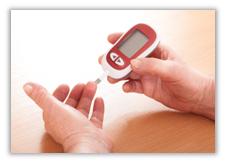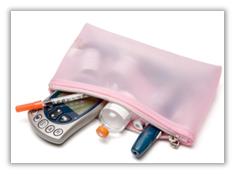

What is Diabetes?
Diabetes is a chronic disease in which the body has trouble regulating blood sugar. Diabetes affects the way the body metabolizes, or uses, digested food to make glucose, the main source of fuel for the body.
The two most common types of diabetes are type 1 and type 2. These two types result from the body's inability to produce and use insulin, respectively. A third type, gestational diabetes, occurs only during pregnancy and may lead to type 2 diabetes.
Insulin is the hormone that controls the movement of glucose from the blood into cells. The pancreas produces insulin. Glucose--also called blood sugar--constantly moves through the bloodstream to supply the body with the energy needed for muscle contractions and metabolism.
The job of insulin is to make sure the glucose actually moves into the body's cells. Without insulin, the glucose builds up in the bloodstream. Over time, elevated glucose levels can damage the linings of blood vessels, leading to damage to the eyes, kidneys, and other sensitive tissues. This vascular damage can cause blindness (diabetic retinopathy), impotence, kidney failure (diabetic nephropathy and end-stage renal disease), increased risk for heart attack, and the deterioration of nerves or blood vessels. It also can cause poor blood flow to the arms and legs, resulting in poor wound healing and possible amputation. Diabetes is the leading cause of new blindness in adults. It is also the most common condition leading to dialysis and kidney transplants, and the most common reason for below-the-knee amputations.

Type 1 Diabetes:
Type 1 diabetes is caused when the cells in the pancreas (called beta islet cells) that produce insulin are destroyed. Although type 1 diabetes can occur at any age, it is usually diagnosed in children and young adults. Genetic, autoimmune, and environmental factors are considered risk factors for type 1 diabetes. Currently, there is no known way to prevent type 1 diabetes.

Type 2 Diabetes:
Type 2 diabetes affects about nine out of 10 people with diabetes. In type 2 diabetes, the pancreas either does not produce enough insulin, or the body becomes less and less efficient at getting insulin to move glucose into the cells (insulin resistance). You can inherit the potential for type 2 diabetes, but whether you actually develop it may depend on a number of environmental factors, such as poor eating habits and lack of exercise. Other risk factors include older age and history of gestational diabetes. Race and ethnicity can also influence the occurrence of type 2 diabetes. African-Americans, Hispanic Americans, American Indians, and Native Hawaiians are at a particularly high risk of developing type 2 diabetes and its complications.
For more information related to diabetes basics, health complications, and other general tools, check out the Eat Right for Life resources for Understanding Diabetes.

What type of diet helps manage diabetes?
According to the American Diabetes Association, following a diabetes meal plan can help you keep your blood glucose levels on track. Carbohydrates are foods that have the biggest effect on your blood glucose levels. After you eat carbohydrates, your blood glucose rises. Fruit, sweet foods, starchy foods (such as bread, potatoes and rice), and milk and milk products contain carbohydrates. Although carbohydrates are important for health, when you eat too many at once, your blood glucose can go too high.
Some carbohydrates--potatoes, sweets and white bread, for instance--may raise blood glucose more than others. Better choices are less processed foods with more fiber and nutrients, such as 100 percent whole wheat bread, oatmeal, brown rice, and non-starchy vegetables.
You can manage your blood glucose better if you eat the same amount of food at the same time every day. That keeps your glucose levels stable and helps your medication work best. Physical activity is an important way to control blood glucose, too. Try to exercise at the same time every day. That way you can build the extra calories you need for exercise into your meal plan.
For more information related to this topic, visit the Eat Right for Life Diabetes Health Center.






